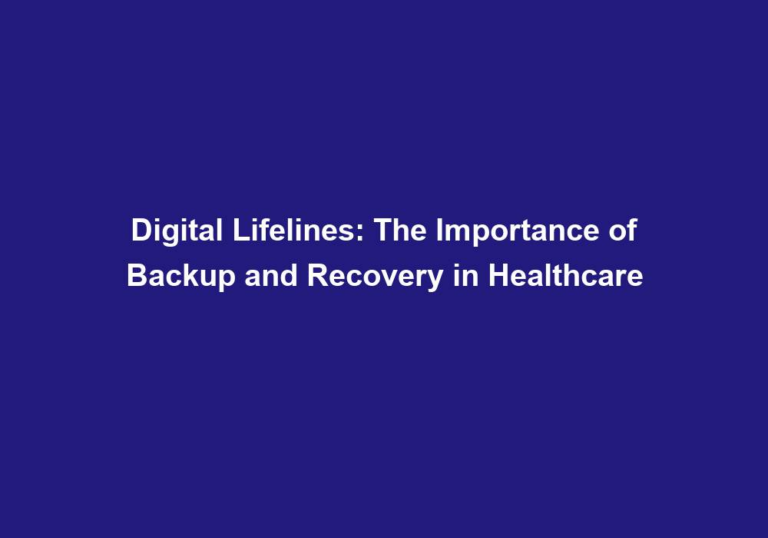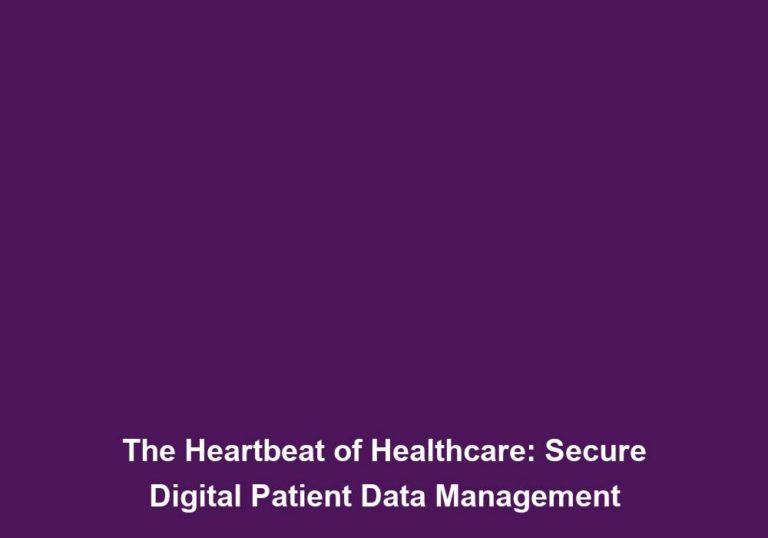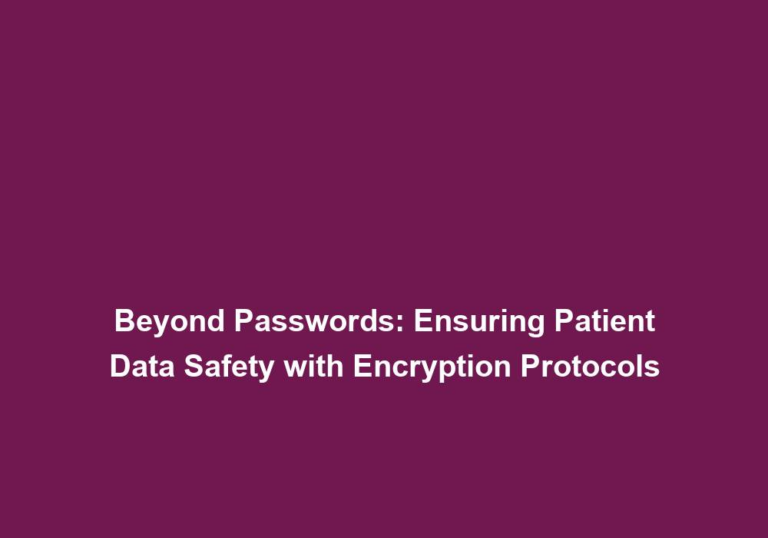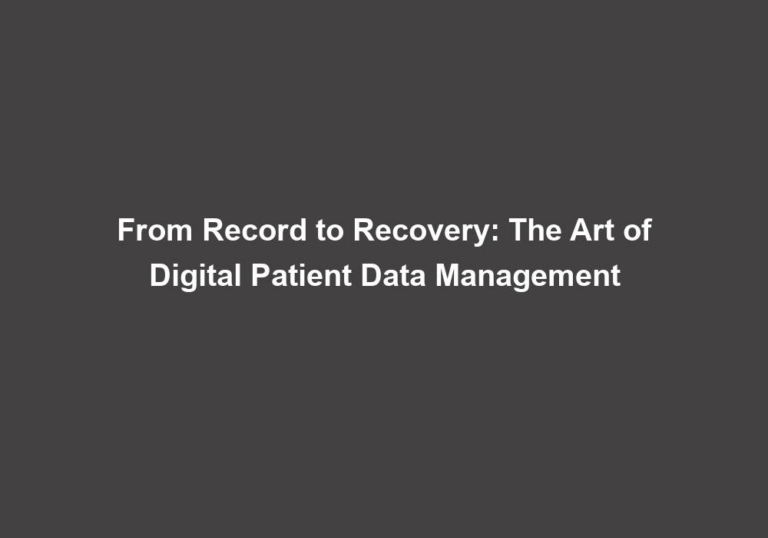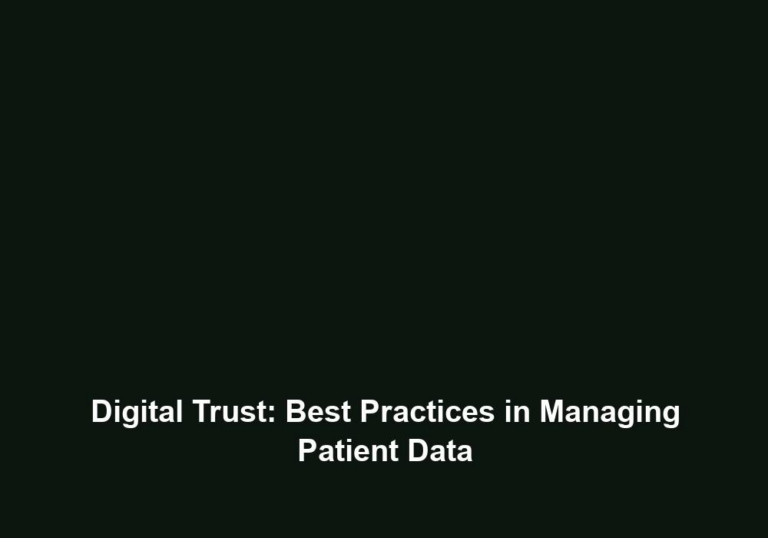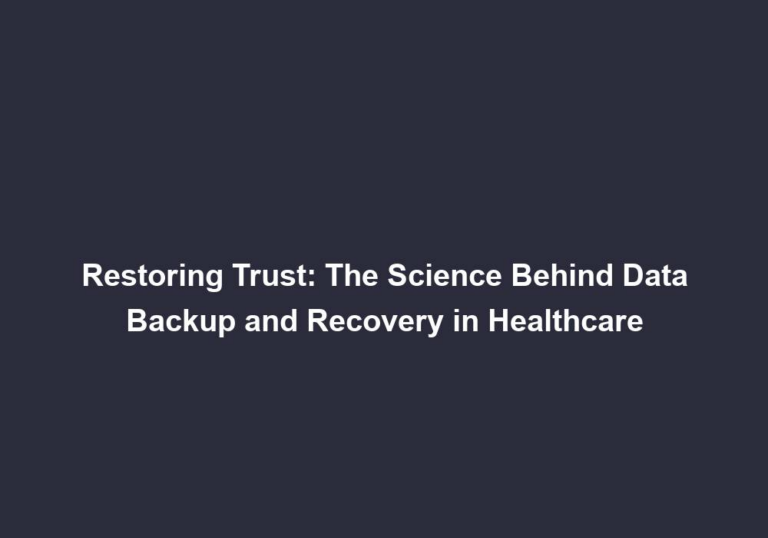Lock and Key: The Role of Encryption in Protecting Patient Data
In an era where technology plays a crucial role in every aspect of our lives, it is no surprise that the healthcare industry has also embraced digital transformation. Electronic health records (EHRs) have revolutionized the way patient data is stored and accessed, making it easier for healthcare providers to deliver efficient and personalized care. However, with this convenience comes the responsibility of safeguarding patient data from potential security breaches. This is where encryption emerges as a crucial tool in protecting patient data and maintaining their privacy.
What is Encryption?
Encryption is a process of encoding information in such a way that only authorized parties can access and understand it. It involves transforming plain text into an unreadable format, known as ciphertext, using an encryption algorithm and a secret encryption key. This encrypted data can only be decrypted and converted back into plain text by using the corresponding decryption key.
Encryption ensures that even if someone gains unauthorized access to patient data, they will not be able to read or use it without the decryption key. This provides an additional layer of security and helps prevent data breaches.
The Importance of Encryption in Healthcare
1. Protecting Patient Privacy
Patient privacy is of utmost importance in healthcare. Encryption acts as a virtual lock and key system that ensures unauthorized individuals cannot gain access to sensitive patient data. By encrypting data at rest, in transit, and while in use, healthcare organizations can significantly reduce the risk of unauthorized access.
Encrypting data at rest refers to the process of encrypting data stored in databases, servers, or any other storage devices. This ensures that even if someone gains physical access to the storage device, they will not be able to read or use the data without the decryption key.
Encrypting data in transit involves securing data as it is being transmitted between different systems or devices. This is particularly important when healthcare organizations exchange patient data with external parties, such as laboratories or other healthcare providers. By encrypting the data during transmission, organizations can prevent unauthorized interception and ensure its confidentiality.
Encrypting data while in use refers to the protection of data that is actively being processed or accessed by healthcare providers. This ensures that even if someone manages to gain unauthorized access to the system, they will not be able to view or manipulate the data without the decryption key.
2. Complying with Regulatory Requirements
Healthcare providers are bound by various regulations and standards, such as the Health Insurance Portability and Accountability Act (HIPAA) in the United States, that mandate the protection of patient data. Encryption is a critical component of regulatory compliance, as it helps organizations meet the requirements for data protection and security.
HIPAA requires healthcare organizations to implement appropriate safeguards to protect the confidentiality, integrity, and availability of patient data. Encryption is specifically mentioned as an addressable implementation specification, meaning that while it is not mandatory, organizations must assess whether encryption is a reasonable and appropriate measure to protect patient data.
By implementing encryption, healthcare organizations can demonstrate their commitment to regulatory compliance and the protection of patient privacy.
3. Mitigating the Risk of Data Breaches
Data breaches can have severe consequences for both patients and healthcare organizations. Encrypting patient data adds an extra layer of protection, making it extremely difficult for hackers to access and misuse the information. In the event of a data breach, encrypted data remains unreadable and effectively useless to unauthorized parties.
Hackers often target healthcare organizations due to the high value of patient data on the black market. By encrypting data, healthcare organizations can significantly reduce the risk of successful data breaches and minimize the potential harm caused to patients.
4. Building Patient Trust
With the increasing number of data breaches reported across industries, patients have become more cautious about sharing their personal information. Implementing robust encryption measures demonstrates a healthcare organization’s commitment to protecting patient data, thereby fostering trust and confidence among patients.
When patients know that their data is being encrypted and secured, they are more likely to feel comfortable sharing sensitive information with their healthcare providers. This trust is crucial for building strong patient-provider relationships and ensuring patients receive the care they need.
Encryption Methods in Healthcare
1. Symmetric Encryption
Symmetric encryption, also known as secret key encryption, uses a single key for both encryption and decryption purposes. This method is fast and efficient, making it suitable for encrypting large volumes of data. However, the main challenge with symmetric encryption is securely distributing the encryption key to authorized parties.
To overcome this challenge, healthcare organizations can use secure key management systems or protocols to distribute and manage encryption keys. These systems ensure that only authorized individuals have access to the encryption key, reducing the risk of unauthorized decryption.
2. Asymmetric Encryption
Asymmetric encryption, or public key encryption, uses a pair of mathematically related encryption keys: a public key and a private key. The public key is freely available and used for encryption, while the private key is kept secret and used for decryption. This method provides a more secure way of distributing encryption keys, as the private key remains with the authorized recipient.
The use of asymmetric encryption in healthcare allows for secure communication between healthcare providers and external parties, such as patients or other healthcare organizations. By encrypting data using the recipient’s public key, healthcare providers can ensure that only the intended recipient can decrypt and access the data using their private key.
Best Practices for Implementing Encryption in Healthcare
To ensure the effective implementation of encryption in healthcare organizations, it is essential to follow certain best practices:
-
Conduct a thorough risk assessment to identify potential vulnerabilities and determine the areas where encryption should be implemented. This assessment should include an evaluation of the types of data being stored, transmitted, and processed, as well as the potential impact of a data breach.
-
Encrypt data both at rest and in transit, using industry-standard encryption algorithms and protocols. It is important to use encryption methods that are widely recognized and have been tested for their security. This includes using strong encryption algorithms, such as Advanced Encryption Standard (AES), and secure transmission protocols, such as Transport Layer Security (TLS).
-
Implement strong access controls to restrict unauthorized access to encrypted data, including the use of multi-factor authentication and role-based access controls. Access to encrypted data should be limited to only those individuals who require it for their job responsibilities. This helps prevent unauthorized decryption and ensures that only authorized individuals can access patient data.
-
Regularly update encryption algorithms and keys to stay ahead of evolving security threats. Encryption technologies and algorithms can become vulnerable over time due to advancements in computing power or the discovery of new vulnerabilities. It is important to stay up-to-date with the latest encryption standards and implement necessary updates to maintain the effectiveness of encryption measures.
-
Develop and enforce robust encryption policies and procedures across the organization, including employee training on encryption practices and data security. Employees should be educated on the importance of encryption, how to properly handle encrypted data, and the potential risks associated with unauthorized decryption. Regular training sessions and reminders can help reinforce encryption practices within the organization.
-
Regularly monitor and audit encryption processes to ensure compliance with regulatory requirements and identify any potential vulnerabilities. Monitoring and auditing can help identify any unauthorized decryption attempts, as well as any weaknesses or gaps in the encryption implementation. Regular assessments and audits can help maintain the integrity and effectiveness of encryption practices.
Challenges in Implementing Encryption in Healthcare
While encryption plays a vital role in protecting patient data, implementing and maintaining encryption practices in healthcare organizations can pose certain challenges:
-
Cost: Implementing encryption technologies can require significant financial investment, especially for smaller healthcare providers with limited resources. The cost of acquiring encryption software, hardware, and the necessary infrastructure can be a barrier for some organizations. However, the potential cost of a data breach and the resulting reputational damage can outweigh the initial investment.
-
Complexity: Encryption can be complex, requiring specialized knowledge and expertise to properly implement and manage encryption systems. Healthcare organizations may need to invest in hiring or training personnel with the necessary skills to handle encryption technologies. It is important to ensure that encryption is implemented correctly to avoid any potential vulnerabilities or weaknesses.
-
Interoperability: Healthcare organizations often need to share patient data across different systems and platforms. Ensuring interoperability while maintaining encryption can be a complex task. Organizations need to ensure that encryption methods are compatible with the systems and platforms they interact with to avoid any data integrity or compatibility issues.
-
User Experience: Encryption can sometimes impact the user experience, such as slower performance or additional authentication steps. Striking a balance between security and usability is crucial. Healthcare organizations should aim to implement encryption measures that do not significantly hinder the user experience, while still providing adequate protection for patient data.
Conclusion
In an age where data breaches continue to threaten the privacy and security of patient information, encryption serves as a powerful tool to protect sensitive data. By implementing robust encryption practices, healthcare organizations can ensure the confidentiality, integrity, and availability of patient data, while complying with regulatory requirements. Encryption acts as the lock and key that safeguards patient privacy, builds trust, and mitigates the risk of data breaches, ultimately allowing healthcare providers to focus on delivering quality care.


